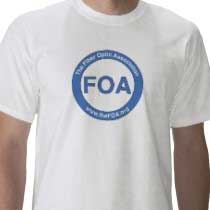Do It Yourself FTTH, Part 2: Connect Anza (Continued)
AEC's electrical backbone was mainly aerial, so it was decided to install cable lashed to a messenger, the cheapest solution. First they had to install the messenger wire, before they installed the fiber cable.

Crew installing messenger wires on AEC poles.
When we said this was a rural system, we were not joking! This is a splicing crew joining two cables on a road less that a mile from the center of Anza. Splicing ws done by contractors because the AEC crew we trained was too busy working on the electrical network.
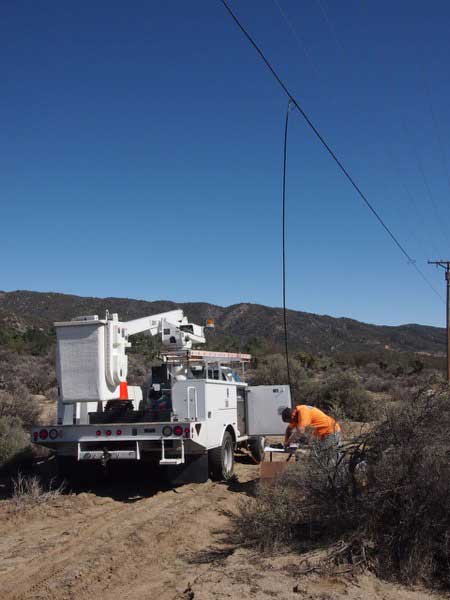
Splicing crew
Given the great California weather, the crew spliced outdoors, being careful to avoid dust.
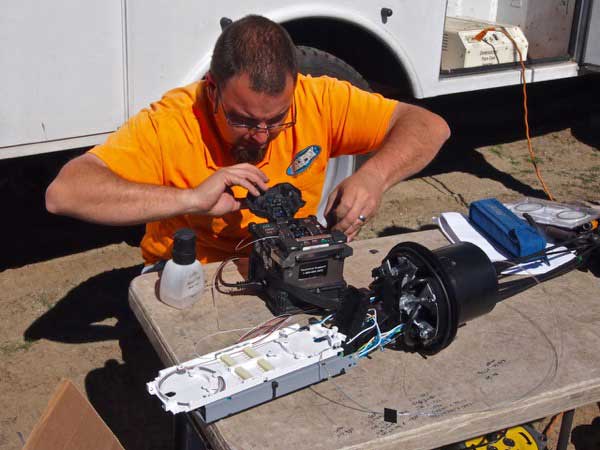
Splicing backbone cables and inserting a 4X splitter
Anza's design used a cascaded splitter design. The splicing tech here is putting a 1X4 splitter in one fiber to handle local drops. The splitter is installed in one side of the splice tray
While the cable plant was being installed, AEC built a head end in their offices. Here's Kevin with the racks of equipement. These two racks have fiber management, power and backup, Internet routers and an OLT. Also in the room was a single rack of servers for the AEC system.

Connect Anza's Servers
That small rack of Adtran equipment is capable of handling 10,000 subscribers! FTTH equipment does not need much room.

Kevin Short, GM of AEC, with the FTTH equipment
Anza Electrical Cooperative is another example of how you can build your own FTTH network. It takes commitment, financing, creating the design, finding suppliers and installers - and most of all, it takes PATIENCE!
Congratulations to Kevin Short, Jeffrey Willis and the crew at Anza Electrical Cooperative for showing everyone how to do it yourself!
Want To Learn More About DIY FTTH?
FOA is creating a series of videos on do it yourself (DIY) FTTH. The first two videos are online now:
FOA Lecture 45 Do It Yourself FTTH (Fiber to the Home) What's involved in building a FTTH network of your own.
FOA Lecture 46 Do It Yourself FTTH (Southern Fiberworx) (FOA Newsletter November 2015) How one company, Southern Fiberworx in Cordele, GA did it themselves.
FOA Lecture 46 Do It Yourself FTTH (Southern Fiberworx) (FOA Newsletter November 2015)
Broadband In Spain Beats Most US Providers
Peter Morcombe is a FOA certified instructor for BDI Datalynk. He came from the UK where he participated in some of the earliest British Telecom fiber installations in the 1070s. He sent us this report on what he learned during his recent holiday in Spain:
During my vacation near Malaga I looked at the broadband services available in the area. Even though this review covers only one supplier it does show that the cost/performance available in Spain is superior to that available in much of the USA.
Services
As with service providers in the USA, Orange offers plenty of “bundles” but to make comparisons easier the prices listed below are for broadband only. The rates shown are in Mega bits/second:
Down Up $/month Terminal equipment
300 300 $34.20 Huawei HG8040
50 50 $28.67 Huawei HG8040
20 1 $22.04 ADSL
For comparison my ADSL (18/1 Mbps) service from ATT costs $45/month. ATT does not offer any higher speeds in my area. One of the things that is driving costs down is the simplification of local terminal equipment.
Verizon FiOS uses ONTs such as the Tellabs 612 and the Alcatel ISAM 7342 which cost over $200 each. Speeds are asymmetric owing to obsolescent ATM technology (ITU G.983 & G.984) topping out at 100 Mbps per home download. Installation is costly as the ONTs are usually installed outdoors with slack boxes and battery backups. The HG 8040 ONT is designed for indoor installation and currently costs less than $60 each.
What next?
I expect “Google Fiber” to shake things up here with the result that prices will drop down to existing European levels or below with spectacular effects on volume. That could make us very busy people if we figure out how to exploit the opportunities.
Loss Budgets - What To Do About The Connectors On Each End?
If you are comparing the loss budget to tested loss, it depends on how you test.

Many designers and technicians wonder when doing a loss budget whether the connectors on the end of the cable plant should be included in the loss budget. When the cable plant is tested, the reference cables will mate with those connectors and their loss will be included in the measurements.
If the "0dB" reference for the insertion loss test was done with only one cable and the light source and power meter, the launch reference cable, which is the most common way, the connectors on the end of the cable will be included in the loss so the loss budget should include both connectors.
If the "0dB" reference for the insertion loss test was done with three cables, the launch reference cable, a receive reference cable and a third reference cable between them, a method used for many plug and jack (male/female) connectors such as MPOs, the loss budget should not include the connectors on the end. When making the "0dB" reference with three cables, two connections are included in setting the reference so the measured value will be reduced by the value of those two connections. If the loss budget is calculated without the connectors on the ends, the value will more closely approximate the test results with a 3-cable reference.
While the two-cable reference method is rarely used, it includes only one connector. Thus you could use the same approach when calculating loss budgets for this test method.
Whatever test method is presumed, it must be documented when the loss budget is calculated.
The History of Multimode Fiber
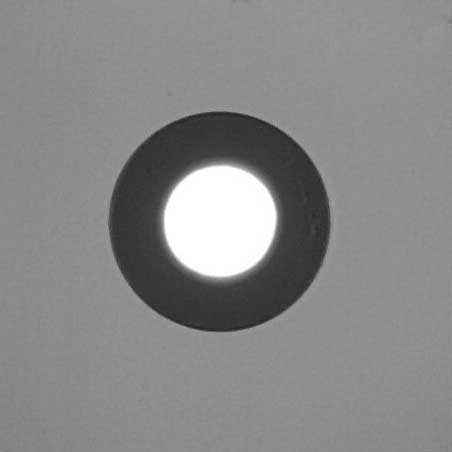
62.5/125 micron multimode fiber viewed in a connector inspection microscope
Last month we discussed WBMMF - wideband 50/125 micron multimode fiber - as one of the big developments of 2015. That has started some discussions on the history of MMF so we dug into our archives and came up with a short history of MMF.
- AT&T's first MMF was 62.5/125 (actually sized as 0.005" diameter) that was used way back in the mid-70s for the first long distance systems and for the data buss on the No.5 ESS subscriber switch (yes, the 1980s A&T subscriber switch used a fiber optic databus - copper was too slow.) My contacts at Bell Labs in the late 70s told me the core diameter at 1/2 the cladding diameter was optimal for bend sensitivity.
- British Telecom experimented with 40/80 fiber I've been told,and there may have been some 50/100 fiber, but the 50/125 was a typical international standards compromise in the late 70s.
- The first long distance networks in the US were Boston to DC and San Francisco to San Diego using 50/125 fiber at 850nm and 45-140Mb/s. They could go 15km (about 45dB) before repeaters.
- AT&T developed 50/125 fiber bandwidth to support 1310nm as well as 850nm in the early 80s with the idea of doing WDM on the links - 850/1310nm - My company (FOTEC) built the equipment AT&T used to assemble the lasers and as part of the deal got to buy lasers for test equipment - we paid $3500 each for the first of them!
- The datacom people did not like the 50/125 fiber because it was hard to couple the LEDs of the day into it efficiently, so they worked with fiber manufacturers to develop a LED fiber, 100/140 microns.
- >100/140 was the favored data fiber until IBM introduced the 3044 Channel Extender around 1985 for mainframes which only specified 62.5/125 fiber. Why 62.5/125? The 3044 used the same transmitters and receivers from the No.5ESS switch (see post above) which AT&T only specified for operation on 62.5/125 fiber!
- Connector manufacturers never made ceramic ferrules for any fibers but 125 micron ODs, (ceramic ferrules, introduced around 1984 with the FC and ST connectors, was a big development that facilitated the acceptance of singlemode fiber) so 100/140 fiber could only use metal ferrule connectors.
- Corning tried to get traction with a LED fiber at 85/125 microns but it gained few proponents.
- After IBM "standardized" on 62.5/125 fiber, everybody else got on the bandwagon. But as data systems went from 10 to 100Mb/s, the higher bandwidth capability of 62.5/125 fiber at 1310nm caused FDDI to use 1300nm LEDs.
- FDDI fiber was specified for bandwidth as 200/500 MHz-km, up from the 160/500 of earlier 62.5/125 fiber. It sufficed for LANs as the standardized fiber through most of the 1990s.
- Gigabit Ethernet and the fast Fibre Channel standards of the late 90s required more bandwidth than FDDI fiber, so a rare version of 50/125 fiber from the mid-80s resurfaced. The lower NA of this fiber and its optimization for 850/1310 nm WDM had led to bandwidth specs of 500/500 MHz-km, ideal for the new 850nm VCSELs. That became OM2 fiber.
- OM3 and 4 fibers were simply developments of higher BW optimized at 850nm to accommodate systems at higher speeds. A back-and-forth between fiber and system manufacturers.
- Wideband MMF was sprung on the world in late 2104 by CISCO who had worked quietly with Finisar, Avago and Prysmian to create a WDM system using VCSELs at 850-950nm. Like every development, vendors are scrambling to make products. CISCO has that power in the networking world!
One final note: WBMMF opens another opportunity that we have not heard discussed yet. The problem with using VCSELs in a WDM system is they are not spectrally "pure"- limiting the closeness of WM wavelengths. There is no reason that F-P lasers with better spectral characteristics cannot be used for more dense WDM in this same range. FP lasers could also be modulated faster than VCSELs. 400G or 1T with WBMMF anyone?
Another Source Of Articles On Fiber
FOA President and editor of this newsletter Jim Hayes has also been writing a column in Electrical Contractor Magazine for more than 15 years now. Electrical contractors do lots of fiber work and this column has covered some toics they are interested in including installation processes, network design, fiber applications and in the last year, a lengthy series on dark fiber - what it is, how's its used and how it benefits the growth of communication. A recent web site redesign makes it easier to browse all these articles - just go to http://www.ecmag.com/contributing-authors/jim-hayes and you can see all of them.
Diagnosing APC Connector Problems
One of the best ways to learn is from your mistakes, or in the case of the FOA, we learn from the mistakes of others who contact us for advice. Here is a summary of a most interesting recent exchange. We reproduce most of the discussion because of the importance of what is being stated here.
A company making >1million patchcords per year found a unique problem. The had a batch of SC/APC patchcords with good loss specs (0.25dB) and passable reflectance (-52dB) but they failed interferometer tests. The radius was off, the centering was off and the angle was marginal. Their question to the FOA was "The RL shows some problem but the IL is really good if we take in consideration the horrible geometry values. Can be that the BAD radius and BAD apex combination in APC polished connectors can lead to good IL value ?"
Fortunately, FOA has some of the most experienced (and smart) people in the business who we can call on for advice. Here is the response from Ed Marg, FOA certified instructor and one of our experts on fiber characterization.
"There are many variables to connector optical performance, not limited to endface geometry. In addition so many combinations of those variables can produce measurements that do not seem not to make any sense. Based on the information given, there are a few of the variables that are suspects that have left clues of what seems to be a mysterious optical performance measurement.
Insertion Loss and Return Loss are not at all tied together with the exception of one common variable. "Endface Separation" will increase both loss and reflection. What causes that endface separation can be very different from one mated pair to another.
With any measurement, the discussion always starts with the instruments that are used to make the measurements, if the instruments themselves are creating the anomaly the discussion ends fast. Our assumption for this discussion will be that we assume that the source, optical power meter and the interferometer are all properly calibrated and the test aid reference patch cord is "Perfect" and the mating adapter is from the same manufacture as the test aid patch cord , and is of reference quality as noted. We will also assume that we are measuring a modern fiber and modern connector, as there is a very big difference between the connectors and fiber that are being manufactured today compared to 10,15 and especially 20 years ago. As you are well aware of, optical performance measurements become difficult at best when old and new are mixed.
I will define Insertion loss as I believe the term is being referenced here in this discussion, as the Loss of optical signal induced by one or a combination of variables from an established reference point where the optical power of the source was measured through the reference quality patch cord directly into a wide area detector, and was the measurement was repeated 10 times with no variation of the measurement at the scales 0.1dB. This reference point is important because it test the mechanical stability of the test connector. There should be no variation whatsoever going into a wide are detector. If there is, the test data in question is no longer valid.
The next point of validation of the test set up is a "Feel", not very scientific, but important none the less. The test aid connector mating adapter must feel the same when the test aid connector is mated with it over and over again ( this includes how it sounds). This translates to the connection under test, it should feel exactly the same, over and over again, and the optical measurement from the mating should be exactly the same when measuring at the .1dB scale, no variation. The reason for this is that "End Separation" of the mated connectors is often caused by mechanical tolerances being offset enough to where a mated pair will often not mate initially then settle in. One additional note specific to APC connectors, not listed as a measurement value is the key offset as this will affect the reflection measurement.
Once you can validate that your measurement has no mechanical issues, then you can begin to look at endface geometry to identify optical loss and how it is affected.
The number one cause of signal loss through a connector is core alignment. Core alignment is affected by APEX Offset and Radius of Curvature as it relates to endface geometry. However, there are many other variables that also can effect loss, but for our discussion we are limiting this to endface geometry.
Reflection is not the amount of signal loss, it is the amount of signal reflected back to the source, and is affected largely by Polish Angle and Apex Offset, the radius of curvature dictates the polishing angle so one can assume that if your radius of curvature is bad for an APC, then the polish angle will also fall out of spec and either increase or decrease your reflection. The accuracy of the interferometer leads me to think their maybe an issue with that measurement because radius of curvature and polish angle are not lining up that well, but I can't put a number to it with the info provided, as it also can be the key angle.
So this is where the discussion goes into a grey area because of limited information, especially when we talk about a measurement scale in the hundredths vs. tenths of a dB, and at a low level 52dB, as reflection measurement, measurement accuracy , can be affected by test equipment and method.
So can a connector have a bad reflection and a good insertion loss, that answer is yes, as the connector having an 8.5 degree angle with an apex offset could cause more of the signal to be sent back to the source while still minimizing the signal loss because of the core alignment and good mode field coupling based on alignment and wavelength being tested. There are additional variables that come into play that we do not know from the information provided, so the simple answer is yes it is possible, and apparent in this case because the measurement confirms it."
Got that? The offset of the apex and angular variation can cause less than a perfect mating which can still lead to OK insertion loss but less than ideal reflectance because the end faces of the mating connectors do not match.
We also got some input from Promet Optics, maker of the FIBO interferometers. Austin Van Sickle pointed us to an interesting paper on this topic. VARIATION IN LINEAR APEX OFFSET MEASUREMENTS OF ANGLED FIBER OPTIC CONNECTORS from which this graphic comes.

The final diagnosis pointed to a batch of patchcords which were made using a non-standard polishing procedure. By re-polishing using diamond film, the maker was able to make these connectors meet spec.
Veterans Send Thanks To Yokogawa For OTDR Used In Class
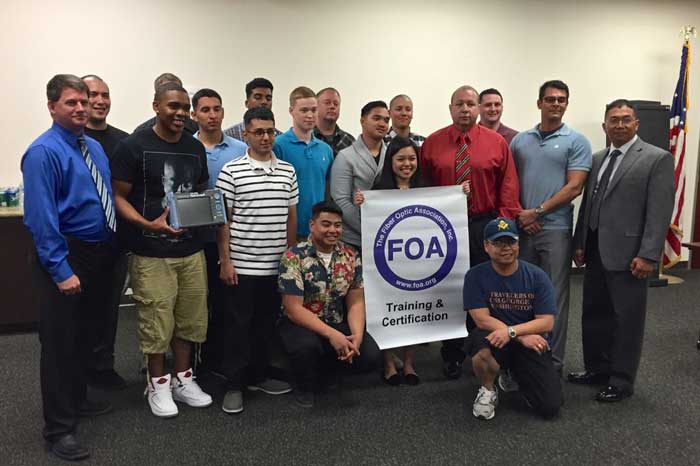
Matt McCool, instructor at the VANC (Veterans Association of North County) fiber optic training course for military veterans and his latest class posed for a graduation photo - and show off the Yokogawa OTDR they hve been using in their labs. The VANC course is offered by Matt and his assistant Brandy Humes in Oceanside, CA near Camp Pendleton to help veterans prepare for working outside the military. FOA has been supporting Matt in giving this course. Yokogawa gave FOA an OTDR last fall for use in our projects and we have loaned it to Matt for use in the VANC courses. The class wanted to express their sincere thanks to Yokogawa!
Does Animation Help Learning?
FOA is trying an experiment. We've been working on some sample animations to see if they clarify some basic fiber concepts. Our first try is on the Fiber Optics, The Basics webpage for Optical Fiber. Our first attempts are used to explain how certain fibers work. Here for example are two graphics explaining total internal reflection in optical fiber.
 was replaced by was replaced by 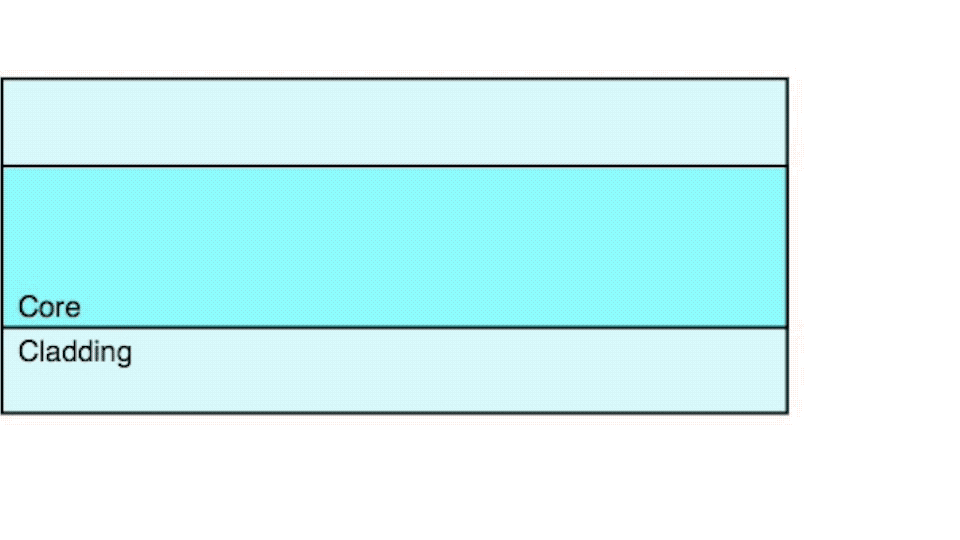
We also created animations to show how step index MMF and graded index MMF transmit light and how one creates a singlemode fiber.
Please take a look at the The Basics webpage for Optical Fiber and let us know what you think. Join the discussion on our LinkedIn groups.
Keep Up With Google Fiber News
Google is moving ahead in Austin and starting in the SE building Google Fiber networks. They just announced projects in San Diego and Irvine, CA and Louisville, KY. Here is where to keep track of what is happening with Google Fiber - the Google Fiber Facebook page!
Fiber Optic Education For Students At Any Age
We hear about fiber optics all the time - it's in the news whenever we hear articles about high tech, the Internet and communications, and many communities are getting "fiber to the home." But few people really understand fiber optics or how it works. FOA is focused on educating the workforce that installs and operates these fiber optic networks but we're always getting inquiries from STEM (science, technology, engineering and math) teachers who want to introduce fiber optics to younger students in K-12 grades or technical schools.

Using red laser light (a VFL here but a laser pointer works also) to show how fiber guides light.
FOA has begun developing a series of YouTube videos intended for teaching students in elementary, middle and high schools about fiber optics. The first FOA video is titled "Fiber Optics For Teachers." With this video, we show teachers how fiber works and carries signals and then explains simple experiments to demonstrate how fiber optics works in the classroom using some plastic fiber and a laser pointer. Since many teachers do not know where to get the fiber, the FOA offers to send them a sample for use in demonstrations in their classroom (USA only right now.)
At the end of the video, teachers are given directions on how to request samples of the plastic fiber from the FOA.
This video joins the "Fiber Optics Live" series How Light Travels In A Fiber, Fiber Attenuation and Connector Loss that show how fiber works using simple experiments that can be duplicated in any classroom. More videos will be coming soon.
If you have kids or know some teachers who would be interested, please send them to the introductory video Fiber Optics For Teachers and we'll be glad to help them get started with some entertaining programs for their classrooms.
Resources For Teachers In K-12 And Technical Schools
Teachers in all grades can introduce their students to fiber optic technology with some simple demonstrations. FOA has created a page for STEM or STEAM (science, technology, engineering, arts and math) teachers with materials appropriate to their classes. Fiber Optic Resources For Teachers.
If you have kids in school or know teachers who are interested, send them to the FOA page Fiber Optic Resources For Teachers.
Should Your Company Become An FOA Corporate Member?
As all FOA individual members know, they join the FOA by becoming certified, mostly taking their CFOTs but some CPCTs, either by attending a FOA approved school or joining directly based on field experience (our "work to cert" program.) Over the years, we've been contacted by manufacturers, contractors, consultants, and other types of organizations who ask about becoming members.
We don't certify companies or organizations, we told them, so we were not sure what we could offer as a benefit of membership. But then, companies asked about using our educational programs to train employees, how they could get listed on the FOA website as service providers or if they could get a quantity discount on membership or certification for all the FOA members working for them. That began to sound like a benefit for being an FOA corporate member. And providing a list of useful suppliers to the market could be a benefit to the industry as a whole.
So FOA has quietly been letting companies and other organizations join the FOA to take advantage of those benefits so we now have several hundred corporate members. We've put then into a database and listed them on the FOA website in map and list form. Here's the map.
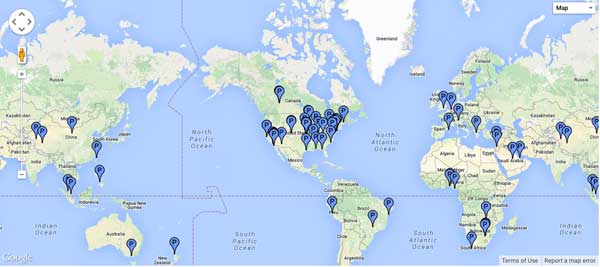
The online map and list can be used to find suppliers and service providers.
The map, like our map of schools, lets you find the FOA corporate members close to you. The table form lists them by category: Installer/Contractor, Component Manufacturer, Installation Equip. Manufacturer, Transmission Equipment, Services/Consulting, Distribution and Users of Fiber Optic Networks. You can sort the tables to find members meeting your needs, e.g. by location, certifications offered, etc. Click on any column heading to sort that column; click twice to sort in reverse order.
How Does An Organization Become An FOA Corporate Member?
Simple, just fill in the online application form. When your application is accepted, you will be asked to pay the membership fee - $100US first year, $50US/year or $100US/3years to renew. You will then be listed on the online map and list, have access to exclusive FOA educational materials for your employees and get discounts on certifications and renewals.
Fiber Optic Asset Protection Symposium, March 8-10, 2016
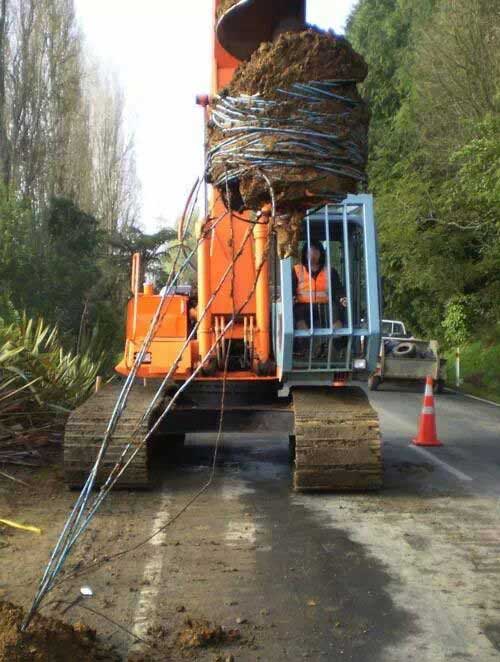
This large auger dug up all those buried cables.
In this newsletter we have discussed the issues of fiber dig-ups many times (Call Before You Dig) but now there is a symposium devoted to the topic.
Damaged fiber can cause outages which can lead to lost customers, repair expenses, and lost revenue. Even worse cable cuts can lead to 911 service disruptions like the cut on January 24, 2015 which knocked out 911 service for thousands of residents and disabled service for 19,000 cell phones, and 4,000 Internet phones. In January 2009, a fiber optic cable that served the data center for a major airline was severed by a contractor in Tempe, AZ resulting in hundreds of grounded flights, thousands of passengers stranded and millions of dollars in lost revenue.
Asset protection begins at project planning and design. At the Fiber Optic Asset Protection Symposium, you can Meet with industry professionals to discuss how to prevent situations like this from happening to you. Attendees will also have access to the 50+ conference sessions, workshops, 100+ exhibits, networking events, new technology demonstrations, and more.
The symposium will be held at the Mirage in Las Vegas on March 8-10, 2016. The 90-minute summit will be held on Wednesday, March 9 from 10:00 am - 11:30 am.
This symposium will help you learn how to avoid these scenarios.
EXFO Offers Super Posters And More

EXFO offers some super posters, guides and books. The FTTx and OTDR posters are really useful! Look at the whole selection here.
What Is The Procedure For Construction Of An OSP Fiber Network?

We recently received an inquiry which we passed along to Joe Botha, author of the new FOA OSP Fiber Optics Civil Works Guide. His answer was a list that provides a simple checklist for OSP construction, so we thought we'd pass it along to everyone.
To answer the question “Please summarize the construction procedure for ODN network” - Joe responded as shown below:
1. Perform a pre-build survey.
2. Obtain Wayleave (easement) agreements.
3. Prepare a Project Management Plan.
4. Prepare a site-specific Environmental Management Plan.
5. Prepare a site-specific Safety Plan.
6. Prepare a Quality Monitoring and Controlling Plan.
7. Businesses / property owner notifications.
8. Trench, lay ducts, close trench, install MHs and perform reinstatements.
9. Perform DCP Testing.
10. Pre-test cables with an OTDR.
11. Perform DIT testing.
12. Blow or haul cables.
13. Fusion splice cables.
14. Acceptance testing i.e. IL, OTDR, etc.
You can download a free copy of the FOA OSP Fiber Optics Civil Works Guide by Joe Botha here.
MPO Connectors
If you are interested in MPO connectors, you should read this Belden white paper "Advances in Multi-Fiber Connectivity." You can download it at http://info.belden.com/multi-fiber-connectivity-digital.
Looking at all these options and adding the options for breakouts on each end, you can see how it's easy to fill 23 pages with diagrams. We've tried to simplify it on an expanded MPO page on the FOA Guide which we recommend you read.
There is a new YouTube video on this part of the MPO polarity -FOA Lecture 44 MPO Connector Fiber Polarity- see below.

New FOA YouTube Videos - Focus On MPO Connectors - Prefab Cabling With MPOs, Testing MPOs and MPO Polarity
We continue to get inquiries about MPO connectors, especially testing them. A continual concern is the variability of loss when testing them. It seems they are not all that repeatable, making testing confusing. We've tried to create materials that explain them and their use. We've recently added three more videos - all focused on the MPO array connector - to the FOA YouTube channel.

The Panduit PanMPO Connector
FOA Lecture 41 Prefabricated (Preterminated) Fiber Optic Cabling Systems
FOA Lecture 42 MPO (Multifiber, Array) Connectors and How To Test Them
FOA Lecture 43 Managing Polarity of MPO Connectors (using the PanMPO Connector)
FOA Lecture 44 MPO Connector Fiber Polarity
Safety On The Job
 
Safety is the most important part of any job. Installers need to understand the safety issues to be safe. An excellent guide to analyzing job hazards is from OSHA, the US Occupational Safety and Health Administration. Here is a link to their guide for job hazard analysis.
FOA also has lots of information on safety: FOA Guide, YouTube video and a Safety Poster
"Worth Reading" Is Now On
Join FOA on Pinterest. We have been posting links to pages "Worth Reading" on a special FOA Pinterest page. You can join and keep up to date with the news on our industry which we put there.
Recent posts cover utilities using new generation telecom, India's plan for 100 smart cities, Cincinnati Bell bets on fiber, various opinions on the US battle over net neutrality, etc.

Good Practice Tools For OTDRs, All Free
FOA OTDR Simulator
You may already know that the FOA has a free OTDR Simulator you can download from our website (go here for directions) that allows you to practice using an OTDR on your PC, seeing the effects of changing setup parameters and analyzing dozens of real world traces. But here are two more tools that can be good for practice.
OTDR FAQs
Including more hints from FOA Master Instructor Terry O'Malley like tests on what the end of a fiber trace looks like with broken and cleaved fibers.
Frequently Asked Questions On OTDRS And Hints On Their Use
"Fiberizer" APP Reads, Analyzes OTDR Traces
Fiberizer is a iPhone/iPad APP that reads industry-standard ".sor" format files and allows trace analysis on your iPhone or iPad. An android version is in the works too. Read more about Fiberizer. And here are more directions on its use.
Events of Interest

The FTTH Council will hold their annual meeting in Nashville, June 13-15, 2016. Register here.
Don't Miss These Seminars and Webinars:

What's going on with all these new higher speed transceivers?
Presented by Robert Reid, Panduit
Available anytime
Optical networking equipment manufacturers who deploy optical transceivers in their products can choose from a variety of different optoelectronic technologies to satisfy higher speed data center requirements, such as deploying multiple fiber lanes (multimode/singlemode parallel optics), Advanced Modulation/Encoding/Error Correction/Dispersion Compensation and WDM (Wave Division Multiplexing).
Register Here.

Installation and Management of Customer-Owned Outside Plant Cabling by Hubbell and Clearfield
The specification, design, installation and management of customer-owned outside plant cabling systems require knowledge, tools and systems that often differ from those used for in-building communication systems. The physical conditions are less benign, which affects everything from installation techniques to the equipment that houses and protects the cabling. This web seminar hosted by Cabling Installation & Maintenance addresses several aspects of customer-owned outside plant cabling administration, emphasizing the capabilities and physical requirements of products and systems deployed in these environments.
Watch anytime - sign up here.
Fiber Testing - Presented By Jim Hayes, FOA
This webcast seminar, presented by Jim Hayes, examines several ways in which fiber testing- both insertion loss and OTDR testing - has evolved. The seminar will begin with a basic tutorial of fiber-transmission principles and test fundamentals. It will then discuss the uncertainties of each fiber-optic measurement method. The seminar will then address some of the developments that have served to improve the certainty of test results, as well as how technicians can use their instruments more effectively to reduce measurement errors.
Watch Anytime - Sign Up Here
~~~~~~~~~~~~~~~~~~
Trends in Fiber Testing & Certification
Presented by Ed Gastle, JDSU
Make sure you're up to date on the current trends and practices for fiber testing and certification.
Now available on demand.
TIA FOTC offers regular webinars and archives them here so you can watch anytime.
~~~~~~~~~~~~~~~~~~~
 New local programs for fiber installation training New local programs for fiber installation training
See the Light® Fiber Optic Training Program
Webinars, seminars and certification training classes.
Corning offers a library of more than 200 videos that help our customers with everything from product preparation and installation to proper testing procedures. Our free Video Library Tool provides direct links to individual Corning videos, and allows you to filter by topic or area of interest. Register to download the Video Library Tool.
~~~~~~~~~~~~~~~~~~
RETURN TO INDEX
 What's Happening @ FOA What's Happening @ FOA

FOA has three LinkedIn Groups
FOA - covers FOA, technology and jobs in the fiber optic marketplace
FOA Fiber Optic Training - open to all, covers fiber optic technology and training topics
FOA School Instructors - a closed group for instructors and administrators at FOA-approved schools
Grupo de La Asociación de Fibra Óptica FOA (Español)
FOA Standards:
FOA now offers free standards for datalinks and testing the installed fiber optic cable plant, patchcords and cable, optical power from transmitters or at receivers and OTDR testing.
What Is A Fiber Optic Cable Plant?
In a recent standards meeting, that issue was discussed with some disagreement as to what constituted a "cable plant." It seemed to be a perfect topic for another FOA "1Page Standard," so a draft version is now uploaded for review (FOA Standard FOA-6, Fiber Optic Cable Plant). Feel free to review it and comment to the FOA at info@thefoa.org.
Available also is a new standard for Datalinks.
Look for the "1 PageStandard" web page and in the FOA Online Reference Guide.
Go to the FOA "1 Page Standards"
NECA/FOA 301 Fiber Optic Installation Standard

Standards cover components and systems and how to test them, but rarely get into installation issues. The FOA NECA 301 standard which covers installation of optical fiber systems has been revised for the second time, adding considerable new materials. This standard is derived from FOA educational material put in standards form and approved by ANSI as an American National Standard. It's specifically written to be used in contracts to define "installation in a neat and workmanlike manner." The standard is available from NECA. FOA members can go here for instructions on how to download your free copy.
New FOA OSP Construction Guide

FOA has some of the world's experts in fiber optic installation as our certified instructors and it is they who contribute much of the FOA technical materials. Master Instructor Joe Botha of Triple Play Fibre Optic Solutions in South Africa has been one of those contributors. Joe has created a training manual for a new course he is teaching on what they call "Civil Works" and we would call construction.
Joe's course is a prelude to the FOA Outside Plant Fiber Optics Course. Before you splice, terminate and test fibers, you must install cables. Before you install cables, you must place poles for aerial construction or dig trenches for underground construction. While that may sound simple and easy, it is no such thing!
The OSP Fiber Optics Civil Works Guide covers the topics that everyone needs to know - whether you are a network owner/user, contractor, designer, installer (cable layer, splicer, tester, etc.) It covers issues like environmental concerns, safety, easements, and more practical topics like how to dig and back fill trenches.
Joe has created a training manual for his "civils" course that he wants the FOA to share with everyone. This 48 page manual covers just about every topic in fiber optic cable plant construction, including a few that you may never have seen in a manual before. This is a very important document for everyone involved in OSP construction to have.
You can download a free copy of the FOA OSP Fiber Optics Civil Works Guide here.
Application of Standard Project Management Processes in Fiber Optic Cable Plant Project Management
By Alfred Sankara, PMP, CFOS/D – Telecommunications Project Manager
Organizations in the communication industry are proving that adopting proven project management practices reduces risks, cuts costs, and improves success rates of projects. The present article demonstrates how standard project management processes apply to fiber optic cable plant project management.
The article compares the Project Management Institute (PMI)’s standards and guidelines to the FOA’s best practices in terms of fiber optic cable plant project management. PMI is the world's leading not-for-profit professional association for the project, program, and portfolio management profession. PMI strives to mature the profession of project management through standards, certifications, resources, tools, academic research, publications, professional development courses, and networking opportunities.
The PMI’s Guide to the Project Management Body of Knowledge (PMBOK ® Guide) defines the project lifecycle as a combination of the following three (3) main phases: Project Initiation, Project Execution, and Project Closing. This article shows that the FOA’s fiber optic cable plant project management lifecycle phases, which include the Design, Installation, and Testing, fit with PMI’s recommended project lifecycle.
Alfred Sankara is a telecommunications specialist who has been active in the planning, deployment, and operations of telecommunications infrastructure since 1999.In the United States and Africa, Alfred has been involved in the execution of various telecommunications projects, including plans and specifications development, fiber optic network deployment (FTTH, SONET, DWDM, Carrier Ethernet, and OTN) and wireless network implementation (WiMAX, Wi-Fi, UMTS, and LTE).Alfred co-founded DigiBridge TelCo to contribute to reduce the digital divide in emerging countries by assisting governmental entities to deploy state-of-the-art telecommunications infrastructure.
Download a copy of Alfred's article on project management for fiber optic construction.
RETURN TO INDEX
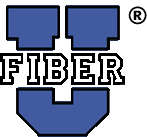
Free Fiber U Self-Study Programs
FOA's "Fiber U" free online self-study programs help you learn about fiber optics, study for FOA certifications or use them to help create "blended learning" classes. There are two new free online self-study programs on Fiber U. Fiber Optic Network Design is for those interested in learning more about how to design fiber optic networks or studying for the CFOS/D certification. FTTx is for those wanting to know more about fiber to the "x" - curb, home, wireless, etc. - or studying for the CFOS/H certification.
Got to Fiber U for more information.
Fiber U Online Self-Study Programs Offer Option Of Certificate of Completion
FOA has been offering quite a few free online self-study programs on Fiber U, our online learning site. We are always getting questions about getting a certificate for completing the course online, so we have setup an option to take a test online and get a certificate of completion for these online courses.
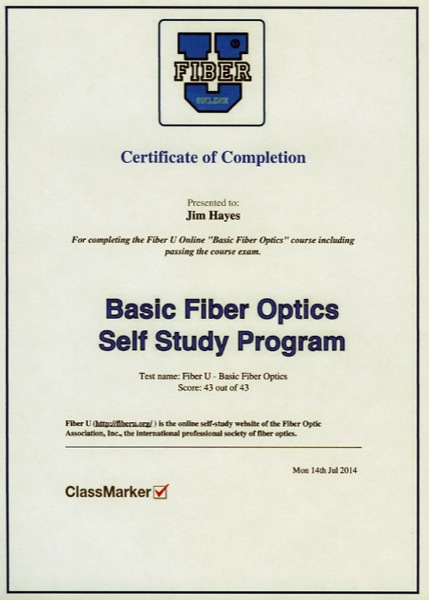
While it's not FOA certification, FOA will recognize a Fiber U Certificate of Completion as background experience to qualify for applying for FOA certifications. We also intend to expand the program to more specialized topics as preparation for FOA specialist certifications.
If you have associates that want to get started in fiber, have them take this course online to get started. Go to Fiber U and get started.
Lennie & Uncle Ted Now Available As Free Books on iTunes
 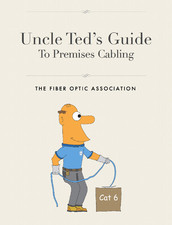
Lennie Lightwave's Guide to Fiber Optics and Uncle Ted's Guide To Premises Cabling are now available free to iPad users who can download them from the Apple iTunes store.
Lennie's Guide has always been the world's favorite introduction to fiber optics. It was first published in the mid-1990s by Fotec, the fiber optic test equipment company famous for its "Fiber U" training conferences and more than 60,000 printed copies were distributed. Lennie was one of the earliest commercial webpages and is still online today (and as popular as ever) at http://lennielightwave.com. Uncle Ted's Guide was created at the request of Lennie readers who wanted a similar simple introduction to "Cat 5" wiring. This latest version of Uncle Ted's Guide covers the all premises cabling topics - wiring, fiber and wireless.
You can find these free guides on Apple's iTunes Store: Lennie Lightwave's Guide to Fiber Optics and Uncle Ted's Guide To Premises Cabling
FOA Textbook Now Available in French / FOA manuel disponible en français

Available from Amazon.com / Disponible sur Amazon.com
And from Createspace / Et à partir de Createspace
FOA Now Offers Fiber Optic Textbook In Spanish
Guía de Referencia de la Asociación de Fibra Óptica (FOA) Sobre Fibra Óptica
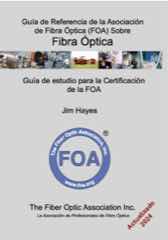
- Reference Books for FOA Certifications available on Kindle and iPad/iPhone as well as printed
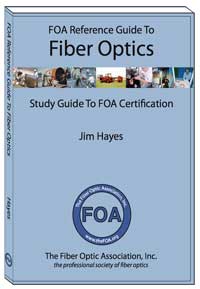 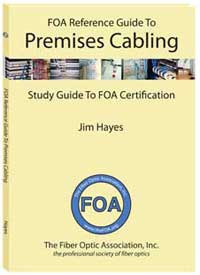 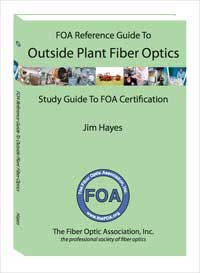
We have created three new FOA books to be used in training for FOA certifications and as reference books for contractors, installers and end users of fiber optics. These books have full curriculum support, including free curriculum materials for teaching FOA certification courses. Because we are self-publishing these books using more modern "publish on demand" technology, they are easier to keep up to date, easier to buy and much, MUCH cheaper!
All are now available in print and electronically in Kindle and Apple iBook versions. The basic fiber optic book is also available as a self-study program in an Apple APP for iPad/iPhone/iPod.
Details on the new book each of the new books are at the book pages linked to the photos above.
RETURN TO INDEX
FOA iPad Apps
FOA LossCalc
 FOA LossCalc estimates the optical loss of a fiber optic link. This will save time for the installer of a fiber optic link needing to know whether test results are reasonable and/or make a "pass/fail" determination. It can also help the designer of a link to determine if communications equipment will operate over this link. FOA LossCalc estimates the optical loss of a fiber optic link. This will save time for the installer of a fiber optic link needing to know whether test results are reasonable and/or make a "pass/fail" determination. It can also help the designer of a link to determine if communications equipment will operate over this link.
By choosing the type of link (singlemode or multimode) and specifying the length of the fiber and numbers of connections and splices, it will calculate the end to end loss of the link. The app has default specifications for singlemode and multimode links or the user may create custom setups with specifications appropriate for any application. http://itunes.apple.com/us/app/foa-losscalc/id476262894?mt=8&ls=1
Self -Study in Fiber Optics
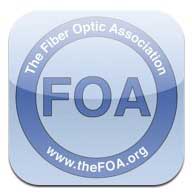 Our first app is a self-study version of the FOA Reference Guide to Fiber Optics. The FOA APP builds on the FOA basic fiber optic textbook to create an interactive learning environment that builds on the iBook electronic version of the book to add a guide to use for self-study and real-time testing that provides feedback on what you have learned and correct answers to questions answered incorrectly. Our first app is a self-study version of the FOA Reference Guide to Fiber Optics. The FOA APP builds on the FOA basic fiber optic textbook to create an interactive learning environment that builds on the iBook electronic version of the book to add a guide to use for self-study and real-time testing that provides feedback on what you have learned and correct answers to questions answered incorrectly.
The FOA APP is priced at only $9.99, same as the iBook, so the self-study program is free. Download it from the Apple APP Store with your iPad or iTunes.
http://itunes.apple.com/us/app/foa-guide/id434354283?mt=8&ign-mpt=uo%3D4
RETURN TO INDEX

The FOA has many videos on  , including two Lecture Series (Fiber Optics and Premises Cabling), Hands-On lectures on both and some other informational and instructional videos. For all the videos, go to the FOA Channel "thefoainc" or use the direct links below. , including two Lecture Series (Fiber Optics and Premises Cabling), Hands-On lectures on both and some other informational and instructional videos. For all the videos, go to the FOA Channel "thefoainc" or use the direct links below.
DIY FTTH
FOA is creating a series of videos on do it yourself (DIY) FTTH. The first two videos are online now:
FOA Lecture 45 Do It Yourself FTTH (Fiber to the Home) What's involved in building a FTTH network of your own.
FOA Lecture 46 Do It Yourself FTTH (Southern Fiberworx) (FOA Newsletter November 2015) How one company, Southern Fiberworx in Cordele, GA did it themselves.
Three New Component/Installation Videos - Focused on MPO Connectors
FOA Lecture 41 Prefabricated (Preterminated) Fiber Optic Cabling Systems
Prefabricated or preterminated fiber optic cabling systems are made in a factory and installed with no need for termination or splicing. This video looks at how they are used, what components typically are used in manufacturing them and then how to design, install and use a prefab cabling system.
FOA Lecture 42 MPO (Multifiber, Array) Connectors and How To Test Them
MPO fiber optic connectors are multifiber array connectors that have from 12 to 72 fibers in a single connector. These connectors are typically used in prefab (preterminated) fiber optic cabling systems or parallel optics links. They have some unique characteristics in their design and use that users need to understand to implement them successfully. This video will look at their unique features and discuss how to use and test them in actual cable systems.
FOA Lecture 43 Managing Polarity of MPO Connectors (using the PanMPO Connector)
MPO connectors are complicated to manage because they have gender (male/female or as it is generally called "pin/no pin" versions) and keying (generally called "key up/key down"). This creates problems having the right patchcords to test or connect them in systems. In this video, we show the variations and how to accommodate them all with one connector - the Panduit PanMPO. (Thanks to Robert Reid and Panduit for samples to use in the video.)
For End Users - Who Think Fiber Needs Maintenance
FOA Lecture 39 Maintaining Fiber Optic Networks
Two New Applications Videos
To accompany new FOA certifications in FTTA and Data Centers
FOA Lecture 37: FTTA (Fiber To The Antenna) and Data Center Cabling
FOA Lecture 38: Data Center Cabling
FOA Product Demonstrations
In the June FOA Newsletter, we talked about the new 3M "disposable" cleaver, the Easy Cleaver, which is provided free with 3M connectors and mechanical splices that need cleavers. We got samples of the Easy Cleaver from 3M and tested them ourselves, and they work great. You can see for yourself how they work in this FOA YouTube Video about the Easy Cleaver.
We also tested the new Ripley/Miller FO-CF Center Feed Fiber Stripper and used it as an opportunity to show the other three common types of strippers, the Miller, MicroStrip and NoNik and how they are used. So you get a review of how to strip fiber and a product review of the new stripper in this FOA YouTube video about fiber strippers.
New FOA Lectures - Jargon and Jobs
How to Talk Fiber Optics - an introduction to fiber optic jargon - the perfect place to start learning about fiber optics.
Where Are The Jobs In Fiber Optics? FOA talks about all the applications for fiber optics, what jobs involve and the qualifications for the workers in the field.
What's A "Network"
That's a common question from fiber and cabling people. Even though they may be installing the cable plants for networks, often the nature of networks is not something they have been exposed to, other than perhaps the catch-all "star network" description. But what is a network? What does it connect? How does it connect users and how does it allocate the bandwidth to them? How do various network types vary?
We've been working on some new YouTube videos on networks, starting as we usually do on a new subject with the basics. We have these three videos online now, but watch for more.
Fiber Optics - Live! A series of videos that use lab demonstrations to show how optical fiber works.
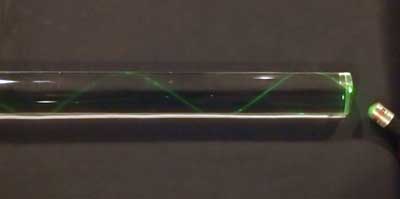
Prepolished/Splice Connector Termination (Panduit OptiCam)
Cabling Project Management - what's involved in a copper/fiber/wireless project -advice for the customer and the contractor
Hazards Of Counterfeit Cable
You may have read the stories we have written about the counterfeit "Cat 5" cable made from copper-clad aluminum rather than pure copper. Recently we tried an unscientific burn test on the cable compared to a known good UL tested cable and posted a video on YouTube. You can see the results below.
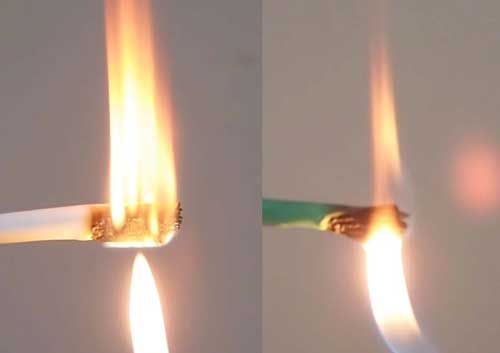
Counterfeit Cable Real UL-rated cable
The difference is obvious and the danger is real. Watch the video on YouTube: Premises Cabling Lecture 11: Counterfeit Cat 5 Cabling
View a complete list of FOA Videos with links to each video on YouTube.
View all the FOA Channel on YouTube.
RETURN TO INDEX

What's New in the FOA Online Fiber Optic Reference Guide?
We have been updating the Online Reference Guide to keep up with changes in the industry and adding lots of new pages of technical information.
Fiber For Wireless: FTTA and DAS
FOA Guide page on Metrology- the accuracy of measurements
Updated page on Data Centers
Le Guide de référence pour la fibre optique de la FOA est maintenant disponible en français.
Updates for new FOA certifications in FTTA and Data Centers
What do you do when you need to test fiber or cable on a reel? Here is a new page on Bare Fiber Testing
Couplers or splitters are used in FTTH and OLANs. How do you Test Splitters?
Tapping fiber has been a big topic in the news. How do you tap fiber?
The page on Optical LANs (OLANs) has been expanded with new material and links.
What's A Network? A simple explanation of network types and operation has been added to the FOA Online Guide.
We have updated the "Datalinks" page.
Three "Quickstart Guides" for fiber optic testing: cable plant & patchcord loss, power and OTDR
Learn More About OTDRs - Download a Free OTDR Simulator
More and more installers are being asked for OTDR testing but using these instruments is not easy. They are hard to set up properly and complicated to interpret the traces. Using the autotest function can lead to disastrous results! The FOA has a good tutorial on OTDRs on our Online Reference Guide and we added a free download of an OTDR simulator to the OTDR section so you can learn how to use an OTDR on your PC.
More New Info:
Links to manufacturers and distributors of fiber optic lighting products.
The FOA Online Fiber Optic Reference Guide has become very popular - perhaps the most popular technical website ever, typically with over 360,000 users downloading about 1.75 million pages in 2011! We continue updating materials regularly, keeping it as up to date as possible.
Find What You Want Using "Google Custom Search
 There's so much information on the FOA Tech Topics and Online Fiber Optic Reference Guide that even a well-organized Table of Contents isn't enough and when the material is always changing, an index is impossible to maintain. So the FOA is using the latest technology in search, Google Custom Search, which will allow you to search just the FOA Tech Topics and Online Fiber Optic Reference Guide for any topic you want to find more about. Try it! There's so much information on the FOA Tech Topics and Online Fiber Optic Reference Guide that even a well-organized Table of Contents isn't enough and when the material is always changing, an index is impossible to maintain. So the FOA is using the latest technology in search, Google Custom Search, which will allow you to search just the FOA Tech Topics and Online Fiber Optic Reference Guide for any topic you want to find more about. Try it!
Go to The FOA Online Fiber Optic Reference Guide.
RETURN TO INDEX
Find An FOA-Approved Training Organization
Most inquiries we get regarding finding a FOA-Approved training organization want to know two things: what school is closest to me or what school offers the certifications I need. The FOA has about 200 training organizations we have approved worldwide so finding the right one can be difficult! We've been looking at ways to make it easier, and we think we've got a good solution. In fact we have two solutions.
First we have added a sortable table of all the FOA-Approved schools.
You can also use our FOA Google Map to find FOA-Approved schools.
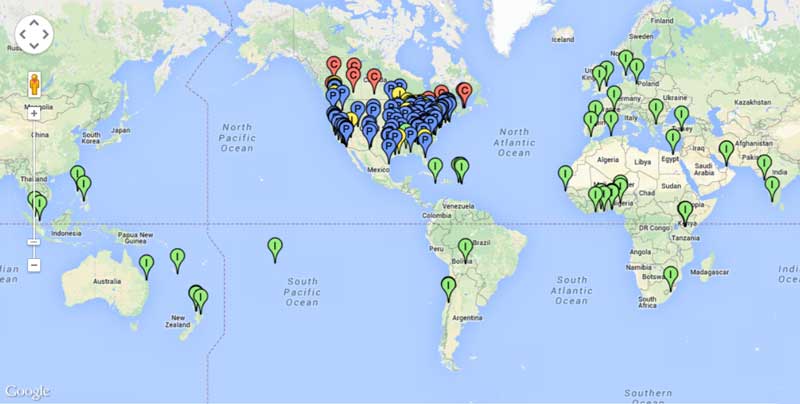
What Should A Fiber Optics or Cabling Tech Know and What Skills Do They Need?
FOA certifications are based on our KSAs - the Knowledge, Skills and Abilities that techs need to succeed. Read the FOA KSAs for fiber and cabling techs.
School News
Feedback
We always enjoy feedback, especially when it shows how great some FOA instructors are. These came from students of Tom Rauch, an instructor at BDI Datalynk:
"I took your fiber optics certification courses this past March. I just wanted to let you know that in two weeks I start working as a fiber optic technician with ___ up in ___. You mentioned on the first day of the course that there is always one guy in class who had rubbed his last two nickels together to be there and, in that instance, I was that guy. Now I'm going to be able to provide for my family like never before and I owe it to the certification that I received from you and BDI Datalynk. I just wanted to thank you again."
"Thanks to our tremendously knowledgeable and patient instructor Thomas Rauch, who was not only generous in sharing his wealth of information, but he did so with ease, humor and in a way that invited curiosity and participation. He was encouraging and proud of our accomplishments and helped us learn from our mistakes in a way that did not break our confidence, rather it pushed us to better results the next go around. The hands on labs were just AWESOME!" Just thought you should know what a class act you have representing you in his travels..... but then again you probably already knew that! : )
In almost 19 years at Verizon and having held numerous positions, I have gone through many training sessions. I cannot remember ever having been actually looking forward to coming back to class quickly after lunch, to get back to the hands on activities, and walking away with the sense of empowerment that the information presented was not only relevant but dead on point accurate! I will be signing up for the Outside Plant class on March! I can't say enough good things about Tom and his impact! Feel free to quote me, I can only imagine that he will open so many doors and change so many lives in the years to come, with his style of teaching! Great experience, awesome job!"
IBEW and FOA Partner on Fiber Optic Training
The International Brotherhood of Electrical Workers (IBEW) and the National Electrical Contractors Association(NECA) through the National Joint Apprenticeship and Training Committee (NJATC) in a partnership with the FOA has published a new textbook for training IBEW apprentices and journeymen in fiber optics. The new textbook uses the material from the FOA Reference Guide To Fiber Optics with new material and photos from other NJATC training partners.
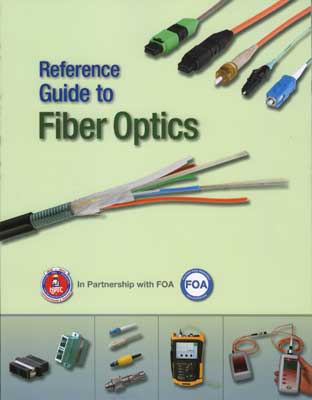
FOA is pleased to have been able to assist the NJATC in the development of this new text. FOA has been a NJATC training partner for many years, including offering instructor training at more than 16 of the NJATC's summer National Training Institutes. A majority of IBEW NECA contractors do fiber optics and low voltage, especially for applications that combine electrical and communications cabling like smart grid, alternative energy, traffic controls, data centers, etc.
Quote from one of our certified instructors: I want to thank you and your organization for all the resources you provide for the students and the opportunity to offer the certification to the students. The fact that you published the book yourself to get the cost down and the unlimited free resources on your website shows a commitment to the public that is second to none. I let it be known to the students that the FOA is the best in the industry at supplying knowledge and resources related to the communication industry. I look forward to passing on the information that you provide for the industry.
Great Video About An FOA School And Their Training
BDI Datalynk trains at the Unversity of Central Florida. UCF created this incredible video on the BDI Datalynk program. It shows the power of what they offer on campuses around the US.
Watch the video here: http://www.ce.ucf.edu/Program/2583/Fiber-Optics-Network-Certification-Courses-Non-credit/
For more information, contact Bob Ballard, CFOS/I, BDI DataLynk, LLC, A Vietnam Veteran-Owned Company
www.bdidatalynk.com, Ph: 512-785-9024
RETURN TO INDEX
Good Question! Tech Questions/Comments Worth Repeating
Real Questions From FOA Newsletter Readers
Old Fiber
Q: We are looking at a company’s fiber network which has been laid at various points in time over numerous years. In this process, we are trying to identify the changes that were made to either/both the glass fiber and the cladding. Are there different generations of what was industry standard in creating the fiber? For example, are you able to identify the difference in a fiber that was laid in 1980 versus one laid today? Was the cladding the same size/thickness etc. in 1980 as it is today or has this been modified/improved upon over the years? In all, we are trying to find what modifications have been over the years and how this may improve the life of the network and its capabilities.
A: This is a common problem today. Many network operators are evaluating their fiber networks for upgrades, hampered by the fact that few are properly documented. Below is a timeline that should answer your questions. What many network owners are doing now is testing their cable plants - a process called Fiber Characterization. There are contractors who do this service.
Fiber Tech Timeline
1976 - First field trials, US and UK, using multimode fiber at 850nm
1980 - First long distance networks still using multimode fiber at 850nm, planning to upgrade with wavelength-division multiplexing at 1310nm
1984 - singlemode fiber becomes feasible, telecom drops multimode fiber, all future installations are singlemode - this first SM fiber with a 9 micron core and 125 micron cladding is still available today but with better specifications. Really early fiber may not have good environmental protection and degrades over time. Early speeds were 145-405Mb/s, up to 810Mb/s by the end of the decade.
1990 - around this time, modern fiber begins - better performance and environmental protection. Fibers for wavelength-division multiplexing in the 1500nm range appear allowing multiple signals on a single fiber and fiber amplifiers allow long spans.
1995-2000 - massive build-out of fiber backbone leads to glut of fiber - WSJ ~2001 says 93% of all fiber is dark. Speeds grew from 1.2-10Gb/s over the 90s decade
2000-date - massive Internet growth and mobile device growth eats up glut of fiber and demands many times more. Dense wavelength-division multiplexing becomes the norm. Speeds began at 1.2/2.5Gb/s, upped to 10, 40 and are now at 100Gb/s.
So most fiber installed after 1990 has the possibility of being used at 10Gb/s, after 2000, it’s probably OK for 40Gb, and since 2010, you are probably OK for 100G and maybe more. To verify performance, you test each fiber for connector condition, loss, spectral attenuation, chromatic dispersion and polarization mode dispersion. There are test sets that will do Fiber Characterization in basically one step.
Splicing The Right Fibers
Q: I have been given a job that will require me to cut an existing 6 count cable in two and splice in a new piece. My problem is that this cable was installed in 1987. From what I have been told there is a good possibility that this cable does not follow present day color codes. Rumor has it that this cable has 3 pairs of Red/White fibers. I was wondering if those pairs are separated by a string or what? Otherwise I will be guessing as to what fiber I am working on. Any information you have on this old fiber type would be greatly appreciated.
A: Color coding for optical cables is unpredictable except for the 1-12 color codes adopted from electrical standards.
I suggest you head to one end of this cable or the other and look at the ends where it’s terminated - you may be able to see how it’s color-coded there. If not, you have two ways to identify fibers other than color coding. 1. Use a visual fault locator if the cable is short enough from the end to the splice point - about 4-5 km is the max. 2. There is a gadget called a fiber identifier that can clip on a fiber and see if there is traffic or 2kHz tone from a test source. Both instruments are described here: Fiber Optic Test Instruments http://www.thefoa.org/tech/ref/testing/Instruments/instr.html
Ethernet Switches In A Passive OLAN
Q: I’ve design a POL (passive optical LAN) for a 39 level building for renting office area to enterprises. The owner will provide “ONTs” to office area where the renters should prepare network switches by themselves. Two questions pop up in my mind:
1. If the renter buys an Ethernet switch, can this switch be directly pugged onto POL’s fiber terminals?
2. Or this L2 should be plugged onto ONT of POL?
A: If I understand the question correctly, you are asking if you can connect a L2 switch with an Ethernet port directly to a OLT. If the OLT uses GPON and does not have Ethernet ports, the answer should be no, GPON and Ethernet are not compatible so the Ethernet switches should be connected to the Ethernet ports on the ONT.
Fusion Splicing Live Fibers
Q: Is it safe to fusion splice a live fiber, or is there a chance that
the light from the arc will damage the detectors in the modules at the end (20km-rated SM for us).
A: I have never heard of this being a problem. The amount of light coupled into the fiber from the splicing would be very small compared to a properly coupled laser. When a cable is broken you might be splicing the fibers that are live without knowing which are live and not caring. On your newer splicers this is not a problem. On the older splicers with the LID system you would have to reduce the power to get a good splice which they would do by putting a bend in the Fiber.
Estimating
Q: I need a source for estimating the cost of fiber optic cable installations. Direct buried, in PVC pipe, Jetting into existing pipe, etc.
A: FOA has a tutorial on estimating fiber optics here: Estimating Fiber Optic Installations
If you are looking for a consultant to do the estimates, I suggest contacting a local contractor, distributor or consultant who can do estimates.
Armored Cable In Conduit
Q: We will be pulling inside of an underground 2" plastic conduit a 144 Strand OSP corrugated armored (coated steel tape) fiber cable Corning 144EUC-T4101D20. The client is asking what we are going to pull along with the fiber to allow - if it is needed in the future- to locate the fiber. Does an additional cable (like tracer wire) need to be pulled if the fiber has already the coated steel tape ?
A: It is very unusual to pull armored cable in conduit - that’s usually a direct-buried cable laid into trenches or plowed in. The heavy weight will make for a lot of friction and may create problems pulling the cable. The armor on the cable should be suitable for later cable location. It’s conductive and would be detectable with many locators.
Upgrade Systems But Still Use 100/140 Fiber
Q: If someone has fibre infrastructure based on 100/140um cable and wants to maintain the cable but update the components on either end….. Do you know of a company who has some sort of converter / adaptor for this type of application?
A: 100/140 was replaced by 62.5/125 fiber in the mid 80s after IBM used it on the 3044 Channel Extender (we helped IBM on that project.) Everybody was scrambling to see if their equipment designed for 100/140 would work on 62.5/125 fiber - and it worked just fine.
The larger fiber gather more light from the LED source so it starts with more power and even if it loses a little at the receiver from a small detector, the result is about the same. I suspect the same is true for today’s equipment.
What you do not want to do is mix fiber types - there is a substantial loss with the joining of 100/140 to 62.5/125 - see Mismatched Multimode Fiber Losses Just make sure the patch cords connecting the equipment are also 100/140 fiber.
Safety Of Underground Fibre Cables
Q. The local phone company has approached me as property owner, as they would like to lay fibre optic cables on my property. I have been doing some research in an attempt to establish the health risks involved with using fibre optics more especially as I have minor children and the cables if laid, will run along (underground - not sure how deep though) my pool area where the kids play. Are you perhaps able to furnish me with information regarding the exact health risks involved - short term and long term please?
A: Fiber optic cable is made from common plastics like polyethylene (PE) or polyvinyl chloride (PVC) which is considered safe and used in many household products. The fiber inside the cable is made of glass, Hava purer form of the glass you use all the time. There is no electrical current flowing, so there is no danger of electrocution or exposure to electromagnetic radiation. The light is not very strong and most systems shut off if the cable has been cut. Cables are buried over 1m under the ground and the trench for the cable is usually filled with gravel or cement. For most homeowners the biggest problem is the destruction of their lawn or garden during construction, but cable owners are usually very good at fixing the problems and/or compensating the homeowner.
Duplex Communications Over One Fiber
Q: Is true duplex over a single fiber possible, or is more like a shared time-domain technique in a quasi-duplex mode? I would guess that true duplex would lead to interference problems.
A. Bidirectional links are widely used - that’s how FTTH PONs work. They use splitters to combine/split the signals and one wavelength downstream and another upstream. See Fiber Optic Datalinks and for FTTH FTTH Architectures.
Power Wires In Fiber Cable?
Q: I would like to inquire if there is a fibre cable combine with electrical cable to carry both data and AC/DC voltage?
A: Many cable manufacturers make so-called “composite” or “hybrid” cables that include fiber an copper conductors. For example, a cable like that is used for fiber to the antenna (see Fiber to the Antenna (FTTA)). Contact your local cable providers.
Passive OLANs For Hotels?
Q: I would Like your opinion on a project I am pursuing at one of my customers, a Hotel ,where the copper analogue lines for the telephone are aging "about 30 yrs." we would like to replace them with a PON ,and also be able to push other services over the new cabling, could you give me the names of some PON equipment manufacturers?
A: Great opportunity for the Optical LAN. Then your customer is future proofed and with unlimited bandwidth and an almost empty Telecom closet. Tellabs, Zhone and Calix are doing hotel installations. It’s even been done in India - see this.
Using Hybrid 2.5-1.25mm Connector Mating Adapters
Q. Can I use the hybrid 2.5-1.25mm adapters for connecting SC connectors to LCs or MU connectors. It would make testing much more convenient.
A: We do not recommend them for most uses, especially testing, as they can be highly unreliable. Reserve them for emergencies and use hybrid patch cords instead.
Test MM Fiber @ 1300nm?
Q: What is your opinion about the need for testing at 1300 nm on OM3 and OM4 fiber especially now that bend insensitive multimode fiber is taking over?
A: It’s unnecessary and costly. It’s rooted in the FDDI/100M days 25 years ago when 1300 LEDs were used and is now obsolete. The only actual uses at 1300nm I know are the extremely rare systems using 1310 lasers which may be standards but simply don’t seem to ever be used. As you say, BI fiber makes the issue of finding stresses moot.
Index Matching Gel In Connectors And Splices
Q: I would like to know if anyone has heard of or knows of any issues pertaining to the Index Matching Gel in prepolished splice connectors or mechanical splices getting cloudy over 5-7 years and failing?
A: We have not heard of any problems with the index matching gel failing over time. That gel is usually a silicone compound that is highly stable and even if it were to cloud there is only a few microns between the fiber ends, hardly enough to cause a problem. There have been many papers written on this topic and long term tests by manufacturers that show no problems.
Fiber In Service Loops
Q: We designing a rural utility system that will be expanded to FTTH (or FTTR - fiber to the ranch in this case). We're wondering how much excess fiber in service loops to add. One software package is asking for 12% but that seems excess.
A: I have typically seen 100 feet on straight through boxes (reserves), 35-50 feet on cut ends for splicing and anywhere from 15-25 feet at the premise depending on how much is required for the termination device, positioning, etc. When rough estimating we have typically used 10% over linear distance.
Cable For High Or Low Temperatures
Q: When manufacturers specify cable for -30 - +70 deg C, are they talking operating or just installation temperature for handling? Here the temperature can go as low as -70 deg C.
A: The manufacturer will specify a temperature range for the cable environment, but the usual expectation is the install gets done in the summer when it’s warmer. A plastic jacket at cold temperatures is very stiff and hard to work with. Special cables for low temperatures are available. We helped plan an install at Scott-Amundsen base at the South Pole during the FOTEC days and they are able to get special cable from most manufacturers to test. It worked well.
Maintenance of Fiber Networks
Q: Can you guide me how to prepare Optical Fiber Cable Annual Maintenance Proposal?
A: Basically, the network needs to be installed properly, fully tested and everything carefully documented. Then no routine maintenance is required. Most problems with fiber optic networks occurs when techs are working with it, e.g. damaging cables or getting connectors dirty when testing, so leaving it alone is the best plan.
Electronic transmission equipment can be tested anytime to ensure proper data transmission, but that does not involve accessing the fiber.
We have several things which may be of help:
You Tube Video: FOA Lecture 39 Maintaining Fiber Optic Networks
Web page: Maintenance
I have 4 questions about OTDRs:
Q: What is dynamic range I read many time but can’t understand yet, whether it is a range of losses can be measured by OTDR for example if an OTDR has 45 dB dynamic range, it can read the losses of point up to 45 dB or what it means.
A: I do not believe there is a standard definition of dynamic range, but it is generally accepted to be the highest loss of the longest cable where you can see the end of the cable. That usually means using the longest test pulse and most averaging and assuming the end of the cable has a significant reflection.
Q: What is dead zone is it fixed in meters mean an OTDR cannot measure up to initial 5, 10 or 20 meter
A: The dead zone is a function of the pulse width and speed of the OTDR amplifier. For most OTDRs it’s about 2-3 times the test pulse width.
Q: What Type of settings needed before launching a test
A: See FOA Lecture 18: OTDR Setup or the section "Modifying OTDR Setup Parameters For Best Test Results” in OTDR testing. A: Basically you set up wavelength(s), test pulse width (long enough to reach end of cable but short enough for best resolution), index of refraction or group velocity (a function of the fiber type and wavelength) and the number of averages (enough to mitigate noise but not take too long)
Q: Reading a test with 1310nm and 1550nm - why values different for a same length of fiber.
A: The attenuation of the fiber will be different at each wavelength and the index of refraction which is different at each wavelength causes a difference in length. The OTDR measures length by measuring time and then multiplying that by the speed of light in the fiber (which is the inverse of the index of refraction.)
The FOA page "Frequently Asked Questions About OTDRs" answers these questions and more.
Getting Old Cables Out Of Conduit
Q: How do you get old cables out of a conduit when they are stuck?
A: Usually we are concerned about reducing friction when pulling cables through conduit, but sometimes you need to get them out. Here is a page from American Polywater the leading lubricant company with advice on the subject.
Manufacturing Guide?
Q: Is there a guide published by FOA that provides insight as to the process of fiber optic manufacturing? It's my understanding that the guide stresses quality and controls to ensure performance and reduce product loss?
A: We do have a guide for manufacturers. It is mostly aimed at communications systems and components manufacture. Here is a link to download it.
How Long Does Termination Take?

FOA received a request from a consultant recently wondering if we had information on the termination times for fiber optic cables. After some looking in our archives, we realized we had a document online that compared times for various fiber optic termination processes. The paper was written after several FOA instructors did a comprehensive time and motion study on termination processes. The document is about 15 years old but still relevant.
You can read it here in the FOA Online Guide.
Testing Connectors (From A Patchcord Maker)
Q: What are the chief defining standard(s) that specifies connector and assembly IL (insertion loss) and RL (return loss or reflectance) for both SM and MM fiber?
A: The description on our Guide is here: http://www.thefoa.org/tech/ref/testing/test/conntest.html
FOTP-34 covers connector testing as a qualification test for the type of connector - basically a "destructive" test for connector manufacturers.
Reflectance is described on that page and here also: http://www.thefoa.org/tech/ref/testing/test/reflectance.html
Testing an assembly like a patchcord is covered under FOTP-107 http://www.thefoa.org/tech/ref/testing/test/FOTP-171.html
Basic Tests For Fiber Optic Cable Plants
Q: I did some research and I noticed that there is a bunch of tests that can be done to fiber optics and I was wondering if there is a list of primary tests that can be done as a basic test.
A: Fiber optic testing does have a hierarchy of tests.
- At the top of the list is "insertion loss" testing which uses a light source and power meter to test the fibers in the same way that a communications system transmits over the fiber. It is a simple test and the equipment needed is inexpensive.
- Techs will also use a microscope to inspect the fiber optic connectors for dirt and damage, a big issue for fiber.
- The instrument called an "OTDR" takes a snapshot of the fiber using a technique like radar. Most outside plant cables are tested with an OTDR and the data ( the snapshots are called "traces") stored for future reference. OTDRs are more expensive and require more training to use properly.
Here is a link to a page on the FOA Guide site that explains the technical,details: http://thefoa.org/tech/ref/testing/test/OFSTP-14.html
FOA also has information just for users of fiber optic networks, see http://thefoa.org/tech/guides/UG3.pdf
How to Clean POF (plastic optical fiber)
Q: I heard that plastic fibres such as PMMA can suffer damage from cleaning from an alcohol solution. Are there alternate cleaning solutions available for these types of fibres."
A: You can use a 10/90 mix of isopropyl alcohol/water. Typically use with a lint free swab. (from out POF consultants)
Testing Bare Fibers With OTDR
Q: We are starting to test some OPGW cables. We have an OTDR but we don’t find some reusable connectors. If we have to test an OPGW with 48 fibres, we can’t set up 48 SC connectors!
Are there some reusable connectors in the commerce?
A: I assume you mean you need to test with a bare fiber on the OPGW. For testing bare fiber, use a splice, not a connector. Have a long pigtail on the OTDR as a launch cable, long enough for the test pulse to settle, say 100-500m, then use a splice for a temporary connection. You can fusion splice the fibers then cut the splice out or use a removable splice like the Corning Camsplice (http://catalog.corning.com/opcomm/en-US/catalog/ProductDetails.aspx?cid=&pid=17929&vid=18219)
If you use a mechanical splice, you need a high quality cleaver just like with fusion splicing and after several uses, you need to add more index matching gel or liquid - mineral oil works OK. See the FOA page on Testing Bare Fiber.
Is A Flashlight Test Adequate?
Q: I contracted a firm to install an OM3 of 200 meters. On one end I have an SFP 1000SX ,on the other a 1000SX converter from optical to UTP. We made pings but they never reached, and I didn’t see the laser at the extreme of the fiber. They promised me to send me the certification they supposely made ,though they assured me the fiber is ok, because WITH A FLASHLIGHT THEY SENT WHITE LIGHT FROM ONE SIDE TO THE OTHER AND IT WAS VISIBLE. I saw the light too, and I thought the culprit was my switch or my SFP. I want to know: is this a good demonstration that the fiber is ok?
A: A visual continuity test is not adequate - your eye is not calibrated! The power of the lamp is unimportant as each eye’s sensitivity is different. And your eye probably cannot see the light from a 850nm VCSEL source - most people’s eyes are not sensitive at that infrared wavelength. The installer should have tested the link with a light source and power meter (http://www.thefoa.org/tech/ref/testing/test/OFSTP-14.html) and given you the loss in dB. The connectors should also be inspected with a microscope to ensure proper polishing and cleanliness (http://www.thefoa.org/tech/ref/testing/test/scope.html). If the SFP output is -6dBm, what is the power at the receiver? 1000base-SX is supposed to work with 4.5dB loss (see http://www.thefoa.org/tech/Linkspec.htm). The fiber loss should be ~0.6 dB, so you must have >4dB connector losses! That says bad installation! The 1000SX link should work over 200m if the fiber has been properly installed.
Older Fiber?
Q: I have some 62.5 mm and sm inside fiber plant over 20 years old. When is a good time to upgrade?
A: When you need to or have to. If it's working OK, there is no need to upgrade!
"Connector Loss" or "Connection Loss"
Q: I have always counted the loss of a connector as .75 dB (568B-3) and 1.5 for a mated pair. Is that correct?
A: While the industry always says "connector" loss, it is actually "connection" loss. As we explain in the page on termination and splicing (http://www.thefoa.org/tech/ref/basic/term.html) When we say "connector" loss, we really mean "connection" loss - the loss of a mated pair of connectors, expressed in "dB." Thus, testing connectors requires mating them to reference connectors which must be high quality connectors themselves to not adversely affect the measured loss when mated to an unknown connector. This is an important point often not fully explained. In order to measure the loss of the connectors you must mate them to a similar, known good, connector. When a connector being tested is mated to several different connectors, it may have different losses, because those losses are dependent on the reference connector it is mated to."
The TIA spec of 0.75dB is for a mated pair of connectors. If you have been passing connectors tested @ 1.5dB loss....you may have some very bad connectors in your cabling!
Microscope Magnification (11/13)
Q: I am doing a lot of fiber optic jumpers for control systems, either single mode or multimode. I want to get a scope to inspect the ends after I clean them would you recommend a 200X, 400X handheld or one similar to a Noyes OFS 300 200C?
A: We prefer to use lower magnification and have a wider view so I can see more of the ferrule to determine its condition. You can see the fiber effectively at 100X but 200X may be better. 400X may be too much for most tasks like inspecting for cleanliness, but may be good if you are polishing SM for good reflectance. We've used the Westover units for years because they offer two different methods of illumination - direct and at an angle. If you are doing a lot of patchcords, I recommend a video microscope. I've used the Noyes unit that interfaces to a PC to create the FOA Microscope Inspection YouTube video here: http://www.youtube.com/watch?v=IyumH8CiUPQ&feature=youtu.be and it works well.
Recycling Cabling
Q: Who can I contact regarding recycling cable I am removing from a building?
A: Here are some people who say they recycle fiber optic cable or at least know how to do it:
http://www.scottrecycling.com/complete.html
http://www.scrapmonster.com/selloffer/fiber-optic-cable/10400
http://www.dnvkema.com/services/ces/hse/recycling/recycling-cables.aspx
http://tmscrapmetals.com/Recycling.html
Tech Hint: Did You Know You Have A Fiber Optic Tester In Your Pocket?
Yes! That old mobile phone has a camera which may be sensitive to infrared light - lots more than your eye - and can detect light in an optical fiber or from a transmitter. Chris Hillyer,CFOT/CFOS/I, Master Instructor, Northern California Sound & Communication JATC sent us some photos showing how this works. See below or the video now on YouTube. Update: You should check out your old cell phones before you recycle them. We've found older models use sensors which are better at infrared than the newer ones which take better pictures. This is a good use for your old cell phones hiding in the drawer!
Fiber Cleaning
This is a topic we keep reminding everybody about, and here is why:
From a contrator in the Middle East: Here some samples of the connectors for SM fiber already installed in the system we were testing.
 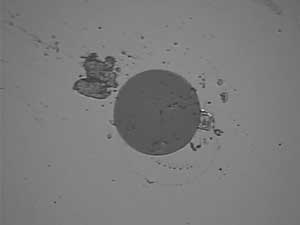
As you can see, the dirt is large compared to the size of the fiber (dark gray), and the core (not visible here) is only 9/125 of the overall diameter of the fiber!
Clean Every Connector - A Lesson We Learned From Creating Lessons
In creating the fiber characterization curriculum, we got inputs from many experienced techs about the testing requirements. Everyone we talked to made a big point about cleaning and inspecting connectors before testing. Dirty connectors are a major problem with errors in testing. We've also seen that many installers think that if a connector, especially new connectors, has a "dust cap" on the connector, it does not need cleaning. WRONG!
The common name for the plastic caps on connector ferrules is "dust cap" and a friend says they are called "dust caps" because they are full of dust. Those plastic caps are made by the millions, popped out of plastic molding machines into barrels and stored until put into plastic bags. Whenever you remove one of them, clean the connector before testing or connecting it.
More on connector cleaning is here and here.
More on cleaning. See Product News below for links to vendors of fiber cleaning products.
What You Need To Know About Fiber Optic Cleaning And More
Ed Forrest, one of the industry experts on cleaning fiber optic connectors, retired about a year ago. We encouraged him to put down on paper what he knew about fiber cleaning and he took our advice. He's now created 4 books on cleaning topics that cover just about everything you need to know. And he added another volume that's also important - maintaining fusion splicers. We recommend these books highly.
How to Precision Clean All Fiber Optic Connections
Understanding Cross-Contamination Points on Fiber Optic Inspection & Test Equipment
Maintaining a Fiber Optic Fusion Splicer
Comparison Study of Precision Cleaning Methods for All Fiber Optic Connection
Whitepaper: The Significance to Optical Internconnect: Properly Cleaning a Fiber Optic Connection
Information on Ed's books is at http://fiberopticprecisioncleaning.com/available-books-whitepapers/.
See news about Fiber Optic Cleaning Videos on YouTube by ITW Chemtronics below.
Fiber Optic Cleaning Videos on YouTube
See news about Fiber Optic Cleaning Videos on YouTube by ITW Chemtronics three fiber optic cleaning videos on YouTUbe covering Dry Cleaning, Wet-Dry Method, FiberWash and Combination Cleaning. They are good explanations of cleaning processes - the Wet-Dry is especially interesting.
- Westover Application Notes And Cleaning Video
- Westover has several application notes on inspecting and cleaning fiber optic connectors. The video is a big file (50+MB) but a good tutorial.
- Download page: http://www.westoverfiber.com/Support/downloads.php
-
Measurement Uncertainty: Everyone testing fiber optics should understand that every measurement has some uncertainty - whether you are measuring loss, length, wavelength, power, etc. Knowing that uncertainty is very important to interpreting the measurement. It's worthwhile to read and understand the issue of measurement accuracy covered in this page of the FOA Online Fiber Optic Reference Guide.
RETURN TO INDEX
Worth Reading or Watching:
FOA "Quickstart Guides"
In our continuing quest to help people understand how to test fiber optic cable plants and communications systems, we've created two more "QuickStart Guides to Fiber Optic Testing." They are simple, step-by-step guides on how to test fiber optic cable plants, patchcords or single cables using insertion loss or OTDR techniques and optical power from transceivers. It's as straightforward as it can get - what equipment do you need, what are the procedures for testing, options in implementing the test, measurement errors and documenting the results.
It can't get much simpler.
Send anybody you know who needs to know about fiber optic testing here to learn how it's done in a few minutes.
Testing Fiber Optic Cable Plants And Patchcords
Testing Fiber Optic Cable Plants With An OTDR
Measuring Optical Power In Communications Systems
New Edition Of Eric Pearson's Fiber Optic "Cookbook"
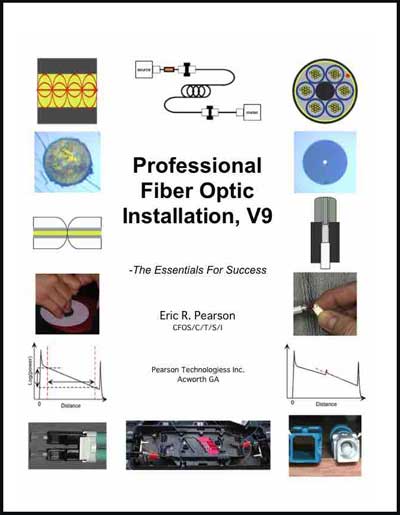
Eric Pearson of Pearson Technologies Inc. announced the availability of Professional Fiber Optic Installation, v.9. This recently updated training, field, and reference text is a comprehensive presentation of the information essential to successful fiber optic installation. This text assists the installer in achieving the three elements of success: low power loss, high reliability, and low installation cost. This text is the ideal tool for three types: those who wish to become professional fiber optic installers; for instructors who want to use the most comprehensive training manual available; and for those who want to pass the Fiber Optic Association CFOT and CFOS/C/S/T certification examinations. Continuously developed and tested over the last 24 years during both fieldwork and training presentations, this text includes both the information essential to understand the reasons for the installation rules and detailed procedures for installation, inspection, certification, and testing of cables, connectors, and splices.
The new edition, #9, is available on Amazon.com.
Like Crossword Puzzles? Here's Some On Fiber Optics

Do you like crossword puzzles? How about one on fiber optics - or maybe a half-dozen of them? FOA Master Instructor Eric Pearson of Pearson Technologies has created a series of crossword puzzles on fiber optics that are keyed to the FOA CFOT reference materials and his book Professional Fiber Optic Installation, v.9. You can have fun and study fiber optics at the same time!
This months crossword puzzle is on "Optoelectronics and Splicing" - Download the crossword puzzle on "Optoelectronics and Splicing."
If you missed the earlier puzzles, here they are:
Download the PDF file of the crossword on "Light and Fiber".
Download the PDF file of the crossword puzzle on "Cables".
Download the crossword on "Connectors & Splices."
Demystifying Singlemode Fiber Types
Singlemode fiber has a lot of names and users are confused by the different names depending on the standards organization you refer to IEC, ITU or TIA designation. Most widely used are the ITU G65X designations but even there we find many designations. Shaun Trezise of M2FX has posted a simple explanation on the company blog that helps explain the different types and where they are used. Read more on the M2FX blog
There is a cross reference to the IEC, ITU and TIA designations on the FOA Guide.
NEXANS FTTO Guide
NEXANS UK has published a FAQ guide explaining the benefits of a "Fibre To The Office" (FTTO) solution as an alternative to traditional structured cabling installations.
Download the guide here.

Want to keep up with gigabit FTTH, try reading or subscribe to the GigCommunities Newsletter.
EXFO Offers Super Posters And More

EXFO offers some super posters, guides and books. The FTTx and OTDR posters are really useful! Look at the whole selection here.
Getting Cables Out Of Conduit
Usually we are concerned about reducing friction when pulling cables through conduit, but sometimes you need to get them out. Here is a page from American Polywater the leading lubricant company with advice on the subject.
What Is The FOA?
Hear FOA President Jim Hayes tell the FOA Story in a 2-part interview by Sound & Video Contractor Contributing Editor Bennett Liles. It tells about the FOA history, goals and achievements.
Part 1: http://svconline.com/podcasts/audio/fiber_optic_association_part1/index.html.
Part 2 http://svconline.com/podcasts/audio/inside-fiber-optic-association2-0924/index.html.
New Textbook On Cleaning Fiber Optic Connectors
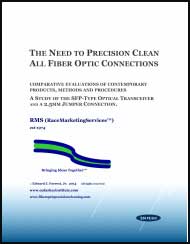
As fiber optic networks become faster and link margins lower, cleaning fiber optic connectors has become more critical. Now there is a book that gives really good information on cleaning from a real expert.
Ed Forrest retired from ITW Chemtronics recently after many years of being their expert on cleaning fiber optic connectors. Ed has been one of our best contacts on the subject because his knowledge is both broad and deep. When he retired, we suggested he write a book on fiber optic cleaning and he took our advice.
Ed's book is like a cookbook, looking at specific cleaning recipes, plus evaluating the tools commonly used for cleaning. It's also in color which makes it easier to see what is being done, although it makes the book a bit more expensive.
Now you can buy The Need to Precision Clean Fiber All Optic Connections, A study of the 'sciences of cleaning', contemporary cleaning products, methods and procedures by Edward J Forrest Jr. The book is available online from CreateSpace, the same publisher FOA uses. Go here for more information on the book: https://www.createspace.com/5120367
What Happens To Old Fibers?
In a recent web search, we found this article from Corning, reprinted from a IWCS presentation in 1995. It discusses extensive tests on a 1984 cable installed in the northern US to see how it had degraded in almost 10 years. It is interesting to see how the fiber survived OSP exposure. Read it here.
Australia's Standard Is Comprehensive Guide To Customer Cabling (Get your copy free)
In answering a recent technical questino, Trevor Conquest in Australia pointed to the Australian Standard "Installation Requirements For Customer Cabling." When we checked, it is on the web and can be downloaded. It's a big book - 220 pages - full of details for fiber and copper installations. We recommend you download yourself a copy - go here.
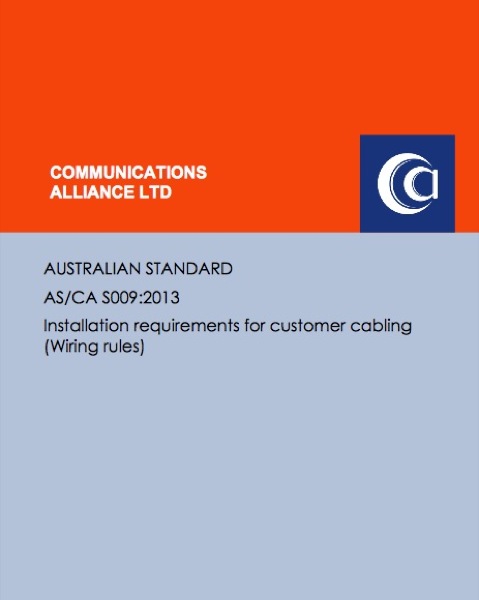
Demystify fiber inspection probe technical specifications - From EXFO
The intent of this application note is to promote a better understanding of video inspection probe specifications and features. Properly understanding the key specifications and features will greatly facilitate the decision process involved in acquiring such devices. Understanding the key aspects of fiber inspection probes will also help users understand how fiber inspection probes operate, thus enabling them to maximize the full potential of these devices. Read more.
Where In The US Do Contractors Need Licenses For Fiber Optics?
We often get asked where in the US do contractors doing fiber optic installations need licenses. We found a good website for that information, the NECA -NEIS website. You might remember NECA-EIS, as they are the partner with the FOA in the NECA/FOA 301 Fiber Optic Installation Standard. NECA is the National Electrical Contractors Association and NEIS stands for National Electrical Installation Standards. They have a very easy to use map and table that gives you data on every state in the US, so mark these pages for future reference.
NECA/NEIS
http://www.neca-neis.org (See “State Regulations”)
http://www.neca-neis.org/state/index.cfm?fa=state_regs (all electrical licensing)
Low Voltage: http://www.neca-neis.org/state/index.cfm?fa=specialty_licensing
How Is Fiber Manufactured?

OFS invites you on a tour of their multimode fiber manufacturing facilities in this new 5-minute video. You will see their highly automated manufacturing operation in Sturbridge, Mass., including their patented MCVD preform fabrication process to fiber draw and final product testing. With a technological heritage dating back to AT&T and Bell Labs, OFS has been manufacturing high-quality multimode fiber since 1981.
Watch the video here.
Interesting Video On Directional Drilling For Fiber Optic Cable Installation
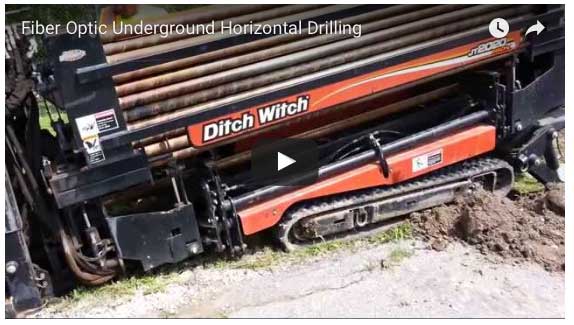
CI&M magazine has posted an interesting video about how Time Warner Cable installs underground fiber optic cable by directional boring. It's a good look at how directional boring works. Watch it here on CI&M's website.
CI&M Editor also does a good review of alternative cable installation methods in an article on the magazine website. Read it here.
Want To Know Where Submarine Fiber Optic Cables Run?
There is a good map online by TeleGeography you can access here.
Benchmarking Fusion Splicing And Selecting Singlemode Fiber
We've been asked many times "How long does it take to splice a cable?" It's not a simple answer as it varies with the number of fibers in the cable and the work setup, including whether one or two techs are working at a job site. FOA Master Instructor Joe Botha of Triple Play in South Africa did his own analysis based on decades of experience both splicing cables and teaching others how to do it properly. This is one of the best analyses we have seen because Joe includes prep times as well as splicing times and differentiates between one tech and two techs working together. He adds some other tips on fusion splicing too. This should be mandatory reading for every tech and given to every student! Here is Joe's splicing analysis.
Joe also has an excellent writeup on how to choose singlemode fiber that helps understanding the different types of G.6xx fiber. Read it here.
And you will want to read Joe's report on splicing different types of SM fiber, including bend-insensitive (G.657) fiber. Read it here.
Free - Mike Holt's Explanation Of The US National Electrical Code (NEC) For Communications Cables
Mike Holt is the acknowledged expert of the US National Electrical Code (NEC). His books and seminars are highly praised for their ability to make a very complicated standard (that is in fact Code - law - in most areas of the US) easily understood. Part of the appeal is Mike's great drawings that make understanding so much easier. Mike makes Chapter 8 of his book available free. It covers communications cables, telephones, LANs, CATV and CCTV, for premises applications. Even if you live in a region or country where the NEC is not the law, you may find this interesting.
Download Mike's Chapter Here.
Fiber Optic Cleaning Videos on YouTube
ITW Chemtronics has three fiber optic cleaning videos on  covering Dry Cleaning, Wet-Dry Method, FiberWash and Combination Cleaning. They are good explanations of cleaning processes - the Wet-Dry is especially interesting. covering Dry Cleaning, Wet-Dry Method, FiberWash and Combination Cleaning. They are good explanations of cleaning processes - the Wet-Dry is especially interesting.
- Westover Application Notes And Cleaning Video
- Westover has several application notes on inspecting and cleaning fiber optic connectors. The video is a big file (50+MB) but a good tutorial.
- Download page: http://www.westoverfiber.com/Support/downloads.php
-
A Documentary Treasure on the History of the Internet
15 minutes of a rarely-seen BBC documentary demolish the myth that ARPAnet was inspired by nuclear war, and explain the far more intriguing truth.
http://www.technologyreview.com/blog/mimssbits/26719/?nlid=4433
Ensuring Distance Accuracy On OTDR Measurements
By JDSU.
JDSU Reference Guide to Fiber Optic Testing
Volume 1 focuses on Basic Fiber testing and Volume 2 is geared toward fiber optic installers, project managers, telecom technicians and engineers who need to understand fiber networks. Volume 2 also covers Chromatic Dispersion, Polarization Mode Dispersion, Attenuation Profile and Fiber Link and Network Characterization. A 3rd volume, a glossary of fiber optic terms, is also available for download.
This is a "MUST HAVE" for all fiber optic techs. Download your free copies here.
We used this book as one of our references in creating a new page in the FOA Online Reference Guide on chromatic dispersion (CD) and polarization-mode dispersion (PMD).
-
- Download yourself a copy and read it!
-
Good Technical Website For Installers
American Polywater (http://www.polywater.com/) has one of the best technical website for cable installers. Check out their website, especially “Videos,” “Engineer’s Corner” and “Calculators.” http://www.polywater.com/NNNBSL.pdf
Fiber Optic Safety Poster
We've had numerous requests to reprint our guidelines on safety when working with fiber optics, so we have created a "Safety Poster" for you to print and post in your classroom, worksite, etc. We suggest giving a copy to every student and installer.
RETURN TO INDEX

" Heard on the Street" is a monthly online newsletter from Frank Bisbee of Communications Planning Corporation that covers the telecommunications and cabling businesses. Each month includes news from manufacturers, trade associations and professional societies like the FOA. You can read the current issue and back issues online.
IGI, a major market research and technology reporting company (the "Active Optical Cables" below) is offering a a free one year subscription to one of our fiber optics newsletters to FOA members. All they have to do is to send IGI an e-mail stating which newsletter they would like to get. See http://www.igigroup.com/nl.html for a listing of IGI Newsletters.
RETURN TO INDEX
-
FOA Tech Topics -
A Fiber Optic Tester In Your Pocket? (See the video on  ) )
Yes! The camera in your old cell phone is sensitive to infrared light - lots more than your eye - and can detect light in an optical fiber or from a transmitter. Chris Hillyer,CFOT/CFOS/I, Master Instructor, Northern California Sound & Communication JATC brought this to our attention.
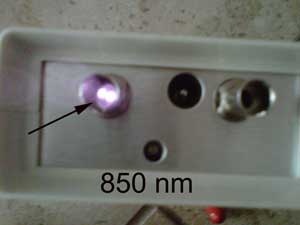 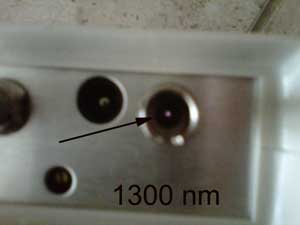
If you have an old cell phone, try it. Our experience is that older cell phone cameras have better sensitivity at IR wavelengths than newer phones, so you may want to toss that old phone into the toolbox.
RETURN TO INDEX
Product News
MPO Connector/Cable Polarity Tester
We've talked a lot about MPO connector and cable polarity and testing in the FOA Newsletter recently and how confusing it can be. ( 7/15, 8/15) Checking Type A, B or C cables and cable plats can be very confusing. OptoTest has introduced a product designed to simplify MPO polarity checking.

The OptoTest_OP280 is designed to verify correct polarity of ribbon fiber connectors, cables, hybrid cables and distribution boxes quickly and conveniently. Each of the twelve fibers is illuminated with it's own bright 635nm red LASER.
The Ribbon Fiber Visual Fault Locator can be used for single mode or multimode applications and is pre-programmed with various sequences for automatic or individual scanning of each fiber. User defined patterns can be programmed via the USB data port. A 5VDC power supply is available to provide a fast charge or a USB port can also be used.
Read more.
Small Armored Cable Aptly Named - TiniFiber
A company named Tinifiber has miniaturized the armored cable. The fiber cables are available in versions with a single strand for Fiber to the Curb (FTTC), Fiber to the Home (FTTH) and Fiber to the Building (FTTB) as well as multiple strands from 1 to 144 (250u/900u/Ribbon) to support all projects needs. TiniFiberTM Duplex Patch Cords – a single tube for both transmitting (TX) and receiving (RX) fibers protects the glass fiber, adds strength with Micro Armor Fiber® and are half the size of conventional patch cords.

Tinifiber construction.
The big advantage of Tinifiber.
Read more here. Watch videos, including how to prep TiniFiber cables here on YouTube.
TRIG BARE FIBER POLISHER
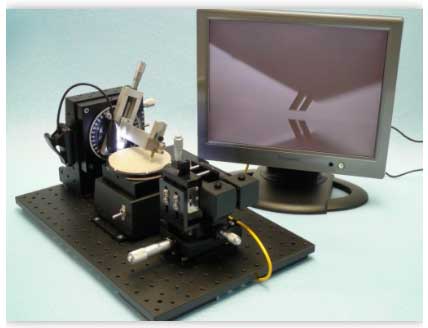
Trig polishes bare fibers at user selectable angles with high repeatability. Video monitoring provides accurate control of the shaping process, while an in-line vision system permits inspection of the polished surface while the fiber is loaded in the machine. Adapters are available for all fiber diameters and types, including PM.
Data sheet.
YOKOGAWA OTDR Has Extended range, High Resolution And Multitasking

One OTDR manufacturer you don't hear as much about is YOKOGAWA (formerly ANDO) which is too bad - they make some of the best OTDRs, exemplified by this new model AQ7280. Need long range - how about 50dB. High resolution - 0.6m dead zone. Like touch screens, but for some functions want hard buttons, it's got that. Options for VFL, microscope, light source and power meter, etc. - it has that too.
But the unique aspect of the YOKOGAWA AQ7280 is it offers multitasking - you can let do a trace with long averages while you inspect connectors, make power readings, use the VFL or other functions.
More info on the YOKOGAWA AQ7280.
FOA thanks Yokogawa for a gift of an OTDR to use for R&D and teaching!
Recycling Communications Cable
FOA was contacted by a company that recycles electronics communications equipment and cabling. CommuniCom recycles cable/metals/e-waste for Telcos and CATVs. They also recycle Fiber Optic Cable and associated Materials (the fiber scrap). And, they reclaim OSP abandoned copper cables (abandoned from road moves or FTTx growth). This is a huge part of our business. They do the work (permitting/locates/labor) for free and we revenue share back with our clients (telcos).
Contact Steve Maginnis
smaginnis@communicominc.com
www.communicominc.com
803.371.5436 (cell)

Micro-Trenching, Cable Removal
Nano-Trench offers products for micro (or I guess they call it nano-) trenching and their website is very informative. They also have Kabel-X, a method of extracting copper cables from old conduit. Both websites are informative and interesting. Watch this video on the cable removal process!
Protecting Pedestals From Rodents
Pedestals and underground vaults can be damaged by rodents who come up through the base and damage cables. Uraseal "Drain N'Seal" foam deters mice from taking up residence in your pedestals. They have some good videos on using their product.
Used Test Equipment – Buy or Sell
http://www.testequipmentconnection.com/
Have you read the FOA pages on cleaning?
- RETURN TO INDEX
FTTH Notes:
- Want To Learn More About FTTx? Try our free online self-study program at Fiber U.
|




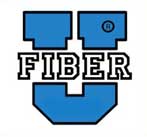











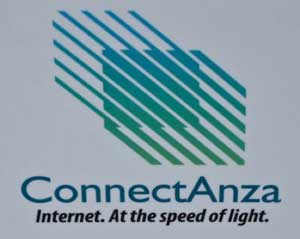
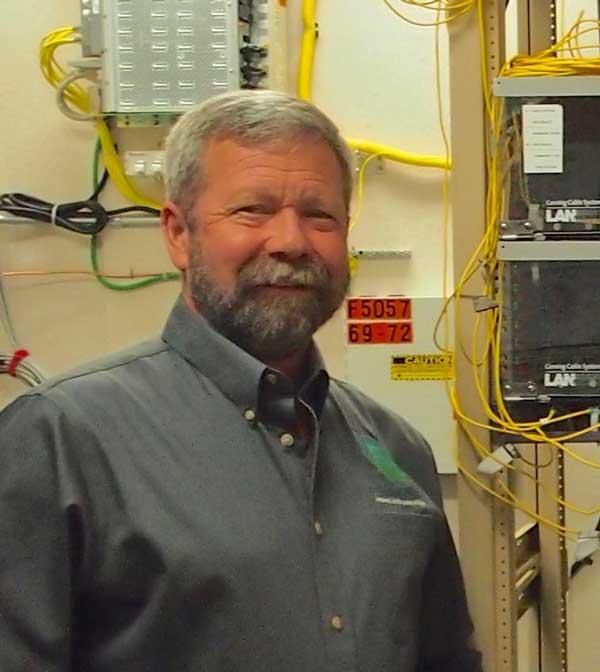



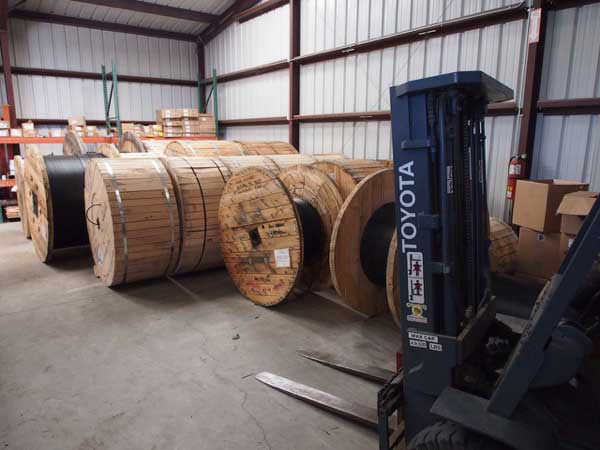








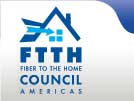









 was replaced by
was replaced by 














































